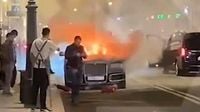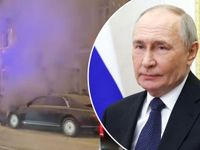On March 29, 2025, a limousine from Vladimir Putin's fleet exploded and caught fire on Sretenka Street in Moscow, near the headquarters of the Federal Security Service (FSB). The vehicle, a black Aurus Senat valued at approximately 330,000 euros, was engulfed in flames, with videos circulating on social media showing the dramatic scene.
Eyewitness accounts reported that the fire appeared to start in the engine compartment before spreading to the interior of the luxury vehicle. Fortunately, the occupants of the limousine were unharmed, though it remains unclear who was inside at the time of the incident.
The explosion and subsequent fire have intensified existing paranoia within the Kremlin regarding potential assassination attempts on President Putin. This incident comes amid heightened concerns about security, particularly following previous attacks on high-ranking officials.
According to reports from the British tabloid Daily Star, the limousine is part of the official fleet used by Putin, who regularly utilizes Aurus Senat vehicles. These cars are manufactured in Russia and were commissioned by Putin himself, with the aim of establishing a domestic production of presidential vehicles. The Aurus Senat has been in use by Putin since 2018 and became available for public purchase in 2021.
As the fire raged, black smoke billowed from the vehicle, drawing the attention of nearby restaurant and bar staff who rushed outside to assist. Emergency services arrived shortly thereafter to extinguish the flames. No injuries were reported, but the cause of the explosion remains unknown.
This incident has sparked speculation about security measures surrounding Putin, particularly given the recent history of targeted attacks within Russia. Just months prior, General Igor Kirillow, a key figure in the Russian nuclear forces, was killed in an explosion involving a bomb concealed in an e-scooter. Such events have led to increased scrutiny and security checks for those in close proximity to the president.
In light of the Sretenka Street incident, security personnel have been seen conducting thorough searches of honor guard members for weapons or explosives, particularly in preparation for public appearances by Putin. This heightened vigilance reflects the growing anxiety within the Kremlin about potential threats, both from external adversaries and within its own ranks.
The Aurus Senat, which is designed for high-ranking officials, comes in several variations, including a long version that resembles the luxury Mercedes-Maybach Pullman. Its price tag of around 330,000 euros makes it one of the most expensive vehicles in the Russian presidential fleet.
As the investigation into the cause of the fire continues, the Kremlin faces mounting pressure to address security concerns amid ongoing tensions in the region and the unpopularity of the government due to the ongoing conflict in Ukraine. The explosion has not only raised questions about the safety of presidential vehicles but also about the overall security protocols in place for protecting top officials.
In a statement following the incident, analysts noted that the explosion could have significant implications for Putin's security strategy moving forward. With public sentiment shifting and the potential for dissent growing, the Kremlin's response to this event may shape future policies regarding both domestic and international security.
While the immediate threat from the limousine fire has been contained, the broader implications of this incident resonate deeply within the halls of power in Moscow. As the world watches, the Kremlin must navigate an increasingly complex landscape of security threats and public perception.
In summary, the explosion of a limousine from Putin's fleet on March 29 has not only destroyed a luxury vehicle but has also ignited fears of assassination attempts and raised questions about the safety of those closest to the Russian president. As investigations continue, the Kremlin's response will be critical in shaping the narrative surrounding this alarming event.





